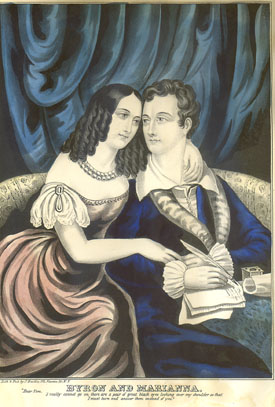Lord Byron in America
He never crossed the pond, but Byron’s impact on U.S. can be seen in Houghton Exhibit

The English poet George Gordon, Lord Byron (1788-1824), was a great fan of the United States. A lifelong admirer of George Washington and Benjamin Franklin, he once said that he envied the explorers Lewis and Clark and wished that he could see American Indians.
Although he never realized his ambition to visit the United States, his books and reputation did cross the Atlantic and had a profound impact here. Nearly 100 editions of Byron’s works were published in America during his lifetime and many more afterward. His verse tales and historical dramas were adapted for the American stage, and the poet’s brooding, rebellious persona inspired numerous imitators.
Byron also met a number of prominent Americans who were traveling in Europe, and many of them had Harvard connections. Edward Everett, the future president of Harvard, met Byron in 1815. So did George Ticknor, Harvard historian and founder of the Boston Public Library, and Joseph Coolidge, Harvard College librarian and future son-in-law of Thomas Jefferson.
And while Byron never sailed to America, he did board the USS Constitution when it was anchored in the Bay of Livorno in Italy in 1821. A rose that he presented to the wife of an American naval officer on that occasion has been preserved to this day in the Beinecke Library at Yale.
A new exhibition at Houghton Library contains numerous items – books, letters, and artworks – pertaining to Byron’s impact on America (the Yale rose, alas, is not among them). “Byron in Nineteenth-Century American Culture” was curated by Houghton acquisitions bibliographer Peter Accardo. The exhibition will remain through October.
The opening of the exhibition was timed to coincide with the 27th International Byron Conference, which began with a series of academic papers delivered at Houghton Library on Aug. 6, then moved on to New York City and the University of Delaware.




